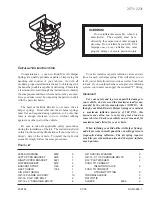
•
You may want to turn off the speed control in hilly terrain if
unnecessary shifting between third and fourth gear occurs.
Unnecessary shifting of this type could result in reduced fuel
economy.
•
Warming up a vehicle on cold mornings is not required and may
reduce fuel economy.
•
Resting your foot on the brake pedal while driving may reduce fuel
economy.
•
Combine errands and minimize stop-and-go driving.
Maintenance
•
Keep tires properly inflated and use only recommended size.
•
Operating a vehicle with the wheels out of alignment will reduce fuel
economy.
•
Use recommended engine oil. Refer to
Lubricant specifications
in
the
Maintenance and Specifications
chapter.
•
Perform all regularly scheduled maintenance items. Follow the
recommended maintenance schedule and owner maintenance checks
found in your vehicle scheduled maintenance guide.
Conditions
•
Heavily loading a vehicle or towing a trailer may reduce fuel economy
at any speed.
•
Carrying unnecessary weight may reduce fuel economy (approximately
0.4 km/L [1 mpg] is lost for every 180 kg [400 lb] of weight carried).
•
Adding certain accessories to your vehicle (for example bug
deflectors, rollbars/light bars, running boards, ski/luggage racks) may
reduce fuel economy.
•
Fuel economy may decrease with lower temperatures during the first
12–16 km (8–10 miles) of driving.
•
Driving on flat terrain offers improved fuel economy as compared to
driving on hilly terrain.
•
Transmissions give their best fuel economy when operated in the top
cruise gear and with steady pressure on the gas pedal.
•
Four-wheel-drive operation (if equipped) is less fuel efficient than
two-wheel-drive operation.
•
Close windows for high speed driving.
Flex fuel (E-85) cruising range
Because E-85 fuel contains less energy per gallon than gasoline, you will
experience an increase in fuel consumption. You can expect your Miles
Maintenance and care
265
















































